This article originally appeared in American Libraries:
Eric Foner—Pulitzer Prize–winning historian, author ofGateway to Freedom: The Hidden History of the Underground Railroad (W. W. Norton, 2015), Columbia University professor, and author of more than 20 history texts—spoke toAmerican Libraries about his latest book and his plans for the future. Foner’s specialty is the American Civil War and Reconstruction, and he has been teaching a popular course on that topic to Columbia undergraduates for more than 30 years. His bookReconstruction: America’s Unfinished Revolution, 1863–1877 (Harper and Row, 1988) is recognized as a definitive work on federal attempts to rebuild the South and establish equal constitutional rights for African-Americans. Foner is giving a talk about the Underground Railroad at the Chicago Humanities Festival on October 31.
Your most recent book is a fascinating look at the Underground Railroad and antislavery networks of pre–Civil War New York City. Explain how you came across the document that shed new light on these events.

ERIC FONER: It was totally accidental. Madeline Lewis, an undergraduate history major at Columbia who also worked for my family as a dog walker, was writing a senior thesis a few years ago about Sydney Howard Gay, an abolitionist editor here in New York City. Gay’s papers, about 80 boxes of them, are in the Columbia Rare Book and Manuscript Library. One day she said to me, “You know, Professor Foner, in one box there is a document having to do with fugitive slaves. I’m not quite sure what it is. It’s not relevant for my work, but you might find it interesting.” So I filed that in the back of my mind, and one day I was in the library and decided to look at that document. It was actually two little notebooks, dating from 1855 and 1856 when Gay was editing the National Anti-Slavery Standard and actively assisting escaped slaves. He kept a record of more than 200 men, women, and children who passed through New York City, and he called it the “Record of Fugitives.”
I had never seen this cited or mentioned by any scholar. It is a fascinating document. Because Gay was a journalist, he interviewed the fugitives. You really can hear the voices of these slaves as they are in the process of escaping. I worked outward from that document to piece together the experience of these slaves, the structure of the Underground Railroad in the 1850s, and eventually the political importance of the fugitive slave issue in American politics before and during the Civil War.
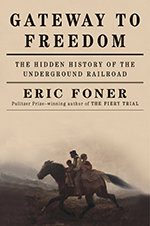
Gay’s record tells some harrowing stories of escaped slaves that you recount in your book. The artwork on the cover shows a slave family fleeing on horseback. Is it true that not all of them escaped on foot? That is a famous painting, A Ride for Liberty—The Fugitive Slaves by Eastman Johnson. One of the funny things about writing books is that the publisher chooses the cover. I had actually wanted something different. Yes, our image of fugitive slaves tends to be a lone individual running through the woods, hiding out in the day and traveling at night. For many that was true, but by the 1850s most slaves escaped in other ways. The transportation network was nearly complete by then, so many slaves escaped on train or by boat. One thing that surprised me was that there were thousands of boats going up and down the Atlantic Coast. Many captains, who weren’t necessarily abolitionists, would take money to hide a few fugitive slaves on board while they were sailing north from Virginia or North Carolina. Other fugitives stole horse-drawn carriages or horses, like in the painting, and just rode off. Some of them did escape on foot, but they tried many other methods as well.
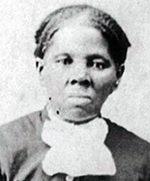
Sydney Howard Gay knew of Harriet Tubman’s efforts to help escaped slaves. What did he write about her? One of the longest entries in this document is his encounter with Harriet Tubman. In fact, she appears twice on two of her trips through New York. Tubman is a unique individual. She escaped from slavery in Maryland in 1849, then in the 1850s went back six or seven times and led out 70–80 people on trips to freedom. Gay tells us the story of her life from her earlier days. He calls her “Captain Harriet Tubman,” which suggests he knew her or knew about her. I’ve never seen anyone during that period call her that. Later on, John Brown called her “General Harriet Tubman.” He promoted her. But that was around 1859. It was fascinating to see her pop up in this document.
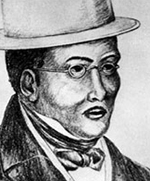
What role did David Ruggles play in New York’s antislavery movement?Ruggles was a black abolitionist in New York City active particularly in the 1830s. We should not think of the Underground Railroad as a highly organized, structured system with regular routes and agents, and passwords and stations. Sometimes people take the railroad metaphor a little too literally. It was basically a set of small local networks that communicated with each other and helped fugitive slaves. If anyone was a founder of the Underground Railroad, it was David Ruggles. In 1835, Ruggles was critical in founding the New York State Vigilance Committee, which was organized for black New Yorkers to stop the kidnapping of free African-Americans off the streets of New York, something that was happening with alarming frequency, particularly with children. Gangs of kidnappers grabbed people, put them on a boat, and sold them into slavery. People are more aware of that now because of the movie 12 Years a Slave.
Very quickly the New York State Vigilance Committee became involved in helping fugitive slaves. It urged other cities to do this, so by 1840 there were vigilance committees in Boston, Albany, and Philadelphia. In a sense, that was the beginning of the Underground Railroad network that passed fugitives along from one node to the other. Ruggles was a key actor.
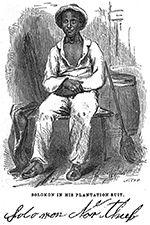
What did you think of the movie12 Years a Slave? I’m not a big fan of Hollywood history. 12 Years a Slavewas pretty good by Hollywood standards. It was strongly based on the book of the same name that Solomon Northup wrote in 1853. It gives you a dramatic, visceral sense of slavery and the violence and oppression and mistreatment that the slaves were subjected to. If people see it, they can learn something about slavery. My problem with it is that this is Hollywood history. There always has to be one hero. I don’t care if it’s Lincoln, Malcolm X, or Gandhi, it’s the “great man” view of history. Maybe that’s inevitable in the genre.
Solomon Northup is portrayed very well, but most of the other slaves are inert. In other words, they have no sense of any class consciousness or resistance. Northup is the catalyst. And that’s true of the book as well, so I’m not complaining. But on the screen, it’s considerably exaggerated.
In 1850, the Fugitive Slave Law was passed. What effect did that have on the Underground Railroad?The Fugitive Slave Law was a draconian law that made the capture and the return of fugitive slaves a federal responsibility. Before then, it had been up to the individual states. Increasingly, many northern states did not want anything to do with this, and they didn’t allow local officials to take part. Southerners got very annoyed and they demanded a national law, which was passed in 1850. So the army, the militias, federal marshals, and federal commissioners were now supposed to take over the capture of fugitive slaves.
The law was directed at the Underground Railroad to some extent, but the result was to catalyze even more resistance and inspire people toward more radical and violent action in the assistance of fugitives, even as it became more dangerous to do so. The Underground Railroad certainly flourished in the 1850s and was not intimidated by the new law.
Did the Fugitive Slave Law make Gay’s Record of Fugitives more dangerous to retain? Yes, that’s a good point. Gay was keeping a record of illegal actions. He could easily be put in jail if someone found it. There were other people active in the Underground Railroad who destroyed their records after the law was passed in 1850. William Still in Philadelphia kept similar records and later said he had to hide them in a graveyard where no one would find them. I don’t know why Gay kept this document. He doesn’t explain why he retained it or why he stopped taking notes after 1860. Maybe he kept other records that haven’t survived.
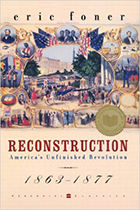
In your 1988 book, Reconstruction: America’s Unfinished Revolution, 1863-1877, you describe Reconstruction as a noble effort to establish an interracial democracy. Why did that fail? In early 1867, Congress mandated the right for black men to vote in the South, a tremendous change in one year. Blacks could hardly vote anywhere before the Civil War, and now they were given new civil rights in new state governments that became the first experiment in interracial democracy in American history.
In my book I quoted Senator Timothy O. Howe from Wisconsin. In a letter to a relative, he wrote: “We have cut loose from the whole dead past and have cast our anchor out a hundred years.” In a certain sense, that’s what happened. It took another 100 years for this country in the Civil Rights Era, which is sometimes called the Second Reconstruction, to implement fully and permanently the principles of legal and political equality that were attempted during Reconstruction. It was a complete break from American tradition, I’m sorry to say, because racism was so deeply ingrained in both North and South. This was a remarkable experiment. I’m not sure I would go so far as to say it was doomed to failure. But you can explain its failure readily by looking at the retreat from equality, violence in the South, the Ku Klux Klan and other groups attacking these new state governments, and the retreat by the federal government enforcing the new laws and constitutional amendments. There are many reasons why Reconstruction failed; what’s really remarkable is that it was attempted at all.
In what ways are Americans still coming to terms with a heritage of slavery? Pick up your daily newspaper. Look at the way policing is done in this country in some places, where black men seem to be targets. Or look at social statistics relating to family income. There was an article in the New York Times about life expectancy, how the gap there has widened between blacks and whites. There are still deep racial disparities in this country. That’s not all the legacy of slavery. Reconstruction was followed by 100 years of Jim Crow segregation, which continued this system of inequality. I don’t want to pass the buck all the way back to slavery. Certainly, racial inequality is a legacy of slavery and we still have it. Despite great progress, we still have a long way to go.
Cape Town, South Africa, has a museum devoted to the Dutch slave trade. Does the US have anything comparable about American slavery? Nothing quite yet. In Charleston, South Carolina, some want to build an International African-American Museum right on the dock where slaves disembarked. In Wallace, Louisiana, the historic Whitney Plantation opened in 2014 and offers exhibits and narratives on slavery, but it’s a little off the beaten path. [There is also a National Underground Railroad Freedom Center in Cincinnati, Ohio.—Ed.] Liverpool, England, and Nantes, France, major slave-trading hubs in the 18th century, have built museums to come to terms with their history. But we have not done that in this country. In Washington, D.C., we have an excellent Holocaust museum. And we should. The Holocaust is something that people want to know about. But we have no museums about slavery. How would we feel if the Germans built a big museum of American slavery in Berlin and had no museum about the European Holocaust? We would think they were trying to avoid something.
In 1995, James W. Loewen wrote a book called Lies My Teacher Told Me, a devastating critique of the inaccuracies in American high school history textbooks. Has accuracy improved in the past 20 years? I have a vested interest in saying yes because I am author of a textbook (Give Me Liberty! An American History) that came out a few years after Loewen’s book, and it is widely used in colleges and in high schools. I feel I’m not telling any lies. Loewen would have to judge how it measures up to his standards. I took on board some of his criticisms of other books in which historical events were misrepresented. Textbooks have improved. Loewen’s book actually stimulated publishers and authors to look at what they were saying and make textbooks more accurate and up to date. The problem with many textbooks is not so much lies, but boredom. Many of them were written by a committee of five or six authors with no coherent, single voice. My book was only written by me. Whatever you like or don’t like, blame me or credit me, but there’s no committee involved.
With so many digital libraries and online historical resources available now, do you find that your methodology for research and writing has changed significantly from years past? Absolutely. Not everything is online, contrary to what many of my students think. For example, the document that I refer to that was the basis of my book was sitting in the Columbia University library. It wasn’t online. It was there to be used, but no one had used it. However, it is online now. Columbia has digitized it and I provided a transcript. The new technology means you don’t have to go to Columbia to read this important document. Certainly, online resources have made our research much easier. I did a tremendous amount of work sitting in my office here, going through digitized copies of black newspapers, anti-slavery newspapers, other newspapers, and anti-slavery collections that are now online. Not everything, but an amazing amount of material.
The newspaper that Sydney Howard Gay edited, The National Anti-Slavery Standard, was not digitized when I wrote the book. It has been since (on the Internet Archive). So I went through that the old-fashioned way. We have it in our library, and I just went through turning the pages for its 20-year run. The problem with digital searching is you find exactly what you’re looking for. If I’m looking for “fugitive,” I’ll find an article that mentions “fugitive.” When you go through it page by page, you find things you weren’t looking for, that often are very valuable and important. Doing research is often about finding surprises.
People say how much material is online, but that doesn’t mean it’s available to everybody. Columbia has bought an enormous number of digital databases. But there are many people I know who teach at very good institutions that can’t afford to get every one of these resources. A friend of mine at Vanderbilt, for example, emailed me and asked me to look at a particular database that contained a copy of a rare pamphlet. Like everything else in our society, the rich are getting richer, and everyone else is falling behind. That’s true in the digital world also.
In your books, you often mention librarians and archivists in the acknowledgments. Have some librarians been particularly helpful to your research over the years? There are the rare book librarians at Columbia who have helped me not only with this one document but with all of the Gay papers. I have enormous respect for librarians and archivists. I have always thanked them in acknowledgments, because you can’t make full use of an archive or a library without their assistance. They know what’s there better than the online guides. Many times in my career, I have been directed to things by librarians that I would not have known to look at. Once you tell them what you are interested in and working on, they say, “Well you might want to take a look at this, or you might want to take a look at that.” So, more power to them.
You will be retiring from teaching soon. What are your plans? I am retiring at the end of spring 2016. I’m not even teaching this term. I have one more course in the spring, and then I ride off into the sunset. However, my lecture course on Civil War and Reconstruction has been put online. It’s now what they call a MOOC, a massive online open course. But it’s free of charge—anybody who wants to see my lectures on this can just click in. They’re all onYouTube and available through edX. I did that because I taught this course for a long time, and I wouldn’t want it to disappear completely, so it will be out there for anyone who wants to see it.
Are you planning any new research or writing projects? Probably down the road, but I’m waiting until after the next term of teaching is over to start thinking about that. I’m sure I will. I’m not just going to Florida to play golf. But I’ll still be a historian.
—–
GEORGE M. EBERHART is senior editor of American Libraries.
